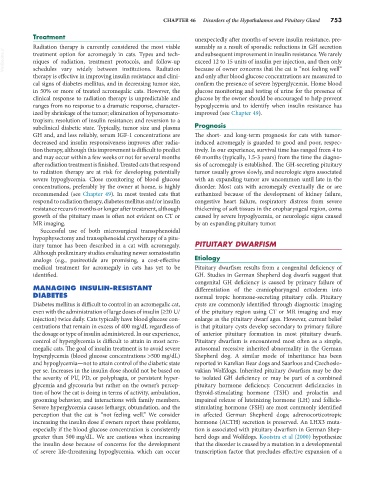Page 781 - Small Animal Internal Medicine, 6th Edition
P. 781
CHAPTER 46 Disorders of the Hypothalamus and Pituitary Gland 753
Treatment unexpectedly after months of severe insulin resistance, pre-
Radiation therapy is currently considered the most viable sumably as a result of sporadic reductions in GH secretion
VetBooks.ir treatment option for acromegaly in cats. Types and tech- and subsequent improvement in insulin resistance. We rarely
exceed 12 to 15 units of insulin per injection, and then only
niques of radiation, treatment protocols, and follow-up
schedules vary widely between institutions. Radiation
and only after blood glucose concentrations are measured to
therapy is effective in improving insulin resistance and clini- because of owner concerns that the cat is “not feeling well”
cal signs of diabetes mellitus, and in decreasing tumor size, confirm the presence of severe hyperglycemia. Home blood
in 50% or more of treated acromegalic cats. However, the glucose monitoring and testing of urine for the presence of
clinical response to radiation therapy is unpredictable and glucose by the owner should be encouraged to help prevent
ranges from no response to a dramatic response, character- hypoglycemia and to identify when insulin resistance has
ized by shrinkage of the tumor; elimination of hypersomato- improved (see Chapter 49).
tropism; resolution of insulin resistance; and reversion to a
subclinical diabetic state. Typically, tumor size and plasma Prognosis
GH and, and less reliably, serum IGF-1 concentrations are The short- and long-term prognosis for cats with tumor-
decreased and insulin responsiveness improves after radia- induced acromegaly is guarded to good and poor, respec-
tion therapy, although this improvement is difficult to predict tively. In our experience, survival time has ranged from 4 to
and may occur within a few weeks or not for several months 60 months (typically, 1.5-3 years) from the time the diagno-
after radiation treatment is finished. Treated cats that respond sis of acromegaly is established. The GH-secreting pituitary
to radiation therapy are at risk for developing potentially tumor usually grows slowly, and neurologic signs associated
severe hypoglycemia. Close monitoring of blood glucose with an expanding tumor are uncommon until late in the
concentrations, preferably by the owner at home, is highly disorder. Most cats with acromegaly eventually die or are
recommended (see Chapter 49). In most treated cats that euthanized because of the development of kidney failure,
respond to radiation therapy, diabetes mellitus and/or insulin congestive heart failure, respiratory distress from severe
resistance recurs 6 months or longer after treatment, although thickening of soft tissues in the oropharyngeal region, coma
growth of the pituitary mass is often not evident on CT or caused by severe hypoglycemia, or neurologic signs caused
MR imaging. by an expanding pituitary tumor.
Successful use of both microsurgical transsphenoidal
hypophysectomy and transsphenoidal cryotherapy of a pitu-
itary tumor has been described in a cat with acromegaly. PITUITARY DWARFISM
Although preliminary studies evaluating newer somatostatin
analogs (e.g., pasireotide are promising, a cost-effective Etiology
medical treatment for acromegaly in cats has yet to be Pituitary dwarfism results from a congenital deficiency of
identified. GH. Studies in German Shepherd dog dwarfs suggest that
congenital GH deficiency is caused by primary failure of
MANAGING INSULIN-RESISTANT differentiation of the craniopharyngeal ectoderm into
DIABETES normal tropic hormone-secreting pituitary cells. Pituitary
Diabetes mellitus is difficult to control in an acromegalic cat, cysts are commonly identified through diagnostic imaging
even with the administration of large doses of insulin (≥20 U/ of the pituitary region using CT or MR imaging and may
injection) twice daily. Cats typically have blood glucose con- enlarge as the pituitary dwarf ages. However, current belief
centrations that remain in excess of 400 mg/dL regardless of is that pituitary cysts develop secondary to primary failure
the dosage or type of insulin administered. In our experience, of anterior pituitary formation in most pituitary dwarfs.
control of hyperglycemia is difficult to attain in most acro- Pituitary dwarfism is encountered most often as a simple,
megalic cats. The goal of insulin treatment is to avoid severe autosomal recessive inherited abnormality in the German
hyperglycemia (blood glucose concentrations >500 mg/dL) Shepherd dog. A similar mode of inheritance has been
and hypoglycemia—not to attain control of the diabetic state reported in Karelian Bear dogs and Saarloos and Czechoslo-
per se. Increases in the insulin dose should not be based on vakian Wolfdogs. Inherited pituitary dwarfism may be due
the severity of PU, PD, or polyphagia, or persistent hyper- to isolated GH deficiency or may be part of a combined
glycemia and glycosuria but rather on the owner’s percep- pituitary hormone deficiency. Concurrent deficiencies in
tion of how the cat is doing in terms of activity, ambulation, thyroid-stimulating hormone (TSH) and prolactin and
grooming behavior, and interactions with family members. impaired release of luteinizing hormone (LH) and follicle-
Severe hyperglycemia causes lethargy, obtundation, and the stimulating hormone (FSH) are most commonly identified
perception that the cat is “not feeling well.” We consider in affected German Shepherd dogs; adrenocorticotropic
increasing the insulin dose if owners report these problems, hormone (ACTH) secretion is preserved. An LHX3 muta-
especially if the blood glucose concentration is consistently tion is associated with pituitary dwarfism in German Shep-
greater than 500 mg/dL. We are cautious when increasing herd dogs and Wolfdogs. Kooistra et al (2000) hypothesize
the insulin dose because of concerns for the development that the disorder is caused by a mutation in a developmental
of severe life-threatening hypoglycemia, which can occur transcription factor that precludes effective expansion of a

